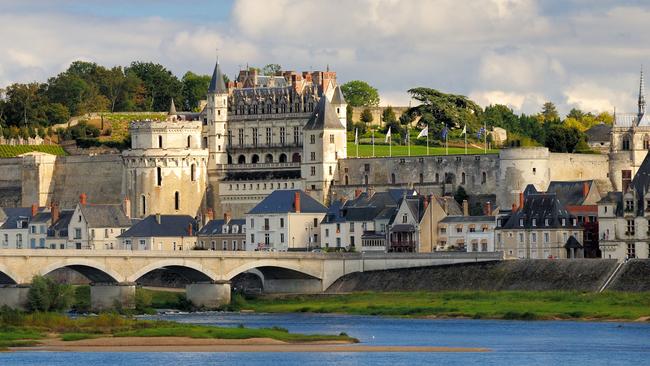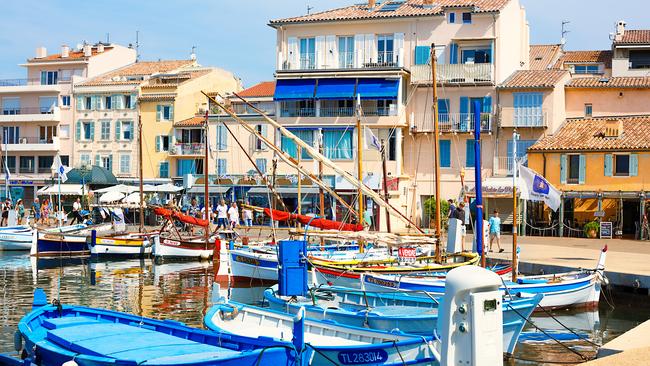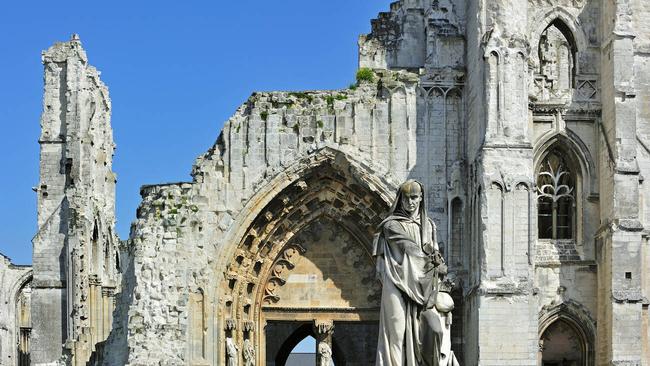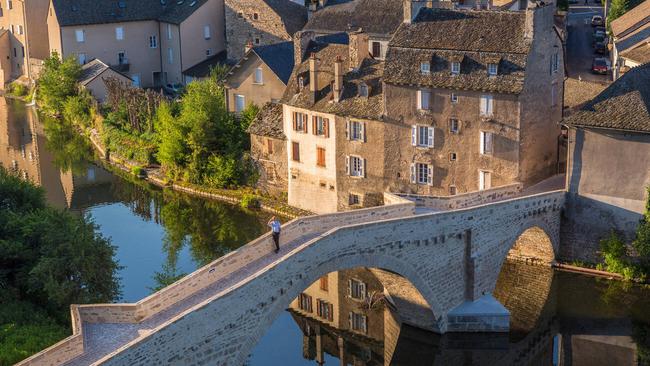The 10 French towns that are better than Paris
Fallen in love with the City of Light during the Olympics? If you want to experience the real France, head to these country locations instead.

The big-hitting host cities of Paris, Nice and Marseilles have had their moments in the Olympic Games spotlight. Now it’s time to turn our attention elsewhere.
I’m increasingly convinced that the small towns of France are the best way for visitors to experience the country. Villages may be great and pretty, but are subject to curtain-twitching and shutting up by 7pm. Big cities have the exciting thrum of urban life but thrust you into queues and off the footpath, and otherwise prove exhausting.

The small town, by contrast, is manageable and stress-free while still rewarding exploration. It won’t be surprised by outsiders and will be able to supply (the equivalent of) Imodium, petrol, a decent dinner and a drink after 10pm. I’ve defined “small town” arbitrarily as having a population between 4000 and 20,000. In truth, I picked the towns I wanted, then fixed the rules around them.
These, my 10 favourites, aren’t invariably the prettiest but have backbone and stories to tell.
Verdun

Population: 15,998
If you want pretty and quaint, go elsewhere. If you want modest heroism, come to Verdun, symbol of all that’s valorous about France’s World War I record. From February to December 1916, about 305,000 men died as the Germans tried to blast their way through to Paris. “They shall not pass,” said General Robert Nivelle. And they didn’t, but it was a close-run thing. Above the town, the former killing fields and forest – more than 16,000ha, reduced to sludge back then – are now tranquil. There have been no new developments. There are skeletons of destroyed villages never rebuilt, new forest, two terrific forts, a monumental ossuary, a startlingly good battle museum and a sense of nobility withal. Meanwhile the town, pounded to smithereens in 1916, wears international renown with hard-bitten restraint. The River Meuse provides a running commentary, and the centre has all the food and drink you need. Verdun combines a bloody past and brighter present with great composure.
STAY: The disarming Hotel de Montaulbain; rooms from €108 ($180) a night.
Cognac

Population: 18,338
Everyone’s heard of cognac, the sleek spirit for international sybarites (not least US rappers such as Jay Z and co; they call it “yak”), but who knows that its home town is a quiet country spot amid one of the comeliest landscapes of southwest France? The tranquil Charente River sets the rhythm. Soft light bathes white stone. The food is good, the drinking better, and life gentle enough to mend the bruised soul. Stroll Vieux Cognac towards the river for a sense of a tight-packed past. Dark stains on the buildings are caused not by filth but by microfungus nourished by evaporating brandy fumes. The Musee des Savoir-Faire du Cognac tells the spirit’s story, including the starring roles taken by folk from Britain: Messrs Hennessy, Martell and Hine. Also Mr Otard, originally from Scotland. His brand – now owned by Bacardi – invests the riverside Cognac chateau, where Francois I, France’s Renaissance king, was born. Thus it provides the best of all the town’s cognac visits.
STAY: In the cabins and overwater lodges of the Quai-des-Pontis; from €98 a night.
Saint-Omer

Population: 14,838
Long near the border with the Spanish Netherlands, Saint-Omer has a strong civil history and a religious past just as grand, as evidenced by its monumental cathedral. From 1593, the English Jesuit college educated Catholic boys denied schooling back in Britain. The town’s most memorable religious feature is St Erkembode’s tomb. Erkembode was an 8th-century bishop who walked his huge diocese unceasingly. As a result, he’s the go-to saint for parents whose children have walking difficulties, and the tomb is covered in kids’ shoes, either beseeching his aid or in thanks for his success. It is immensely touching. That’s a fitting description for this town – touching, and monumental; from the Sandelin museum to the wrecked St Bertin abbey, from the soaring facades of the Jesuit chapel and college, to mountains of carbonade and potjevleesch – the great dishes beloved of beer-drinking people with more sense than money. The town has everything.
STAY: At the Mercure Saint-Omer Centre; from €105 a night.
Douarnenez

Population: 14,121
Douarnenez is a hard-shell Breton fishing port of tough men and women. Prosperity, such as it was, came from sardines. In 1878, 160 million of these little fish were canned here to be exported worldwide. This was considered women’s work. From eight years old to 80, the “sardinieres” prepared the fish – gutting, frying, oiling, packing. In the 1920s they were paid 80c an hour, just enough to buy a litre of milk. Unsurprisingly, 1600 of them went on strike a century ago this year, claiming a (small) victory six weeks later. It was one of Europe’s first great women’s labour struggles, and is being commemorated through 2024. The Port Museum has the story. The bay out front provides breathing space. Across the inlet, the Treboul district has headlands, beaches and seaside bars, and the walking is wonderful. Back in town, the Penn Sardin shop boasts the world’s greatest selection of sardine preparations and brands, in hundreds of gaily decorated cans. It’s seventh heaven for puxisardinophiles (sardine tin collectors).
STAY: The traditional, friendly Hotel de France; from €160 a night.
Aubigny-sur-Nere

Population: 5443
And so to a corner of a foreign field that is forever … Scotland. In the watery green Berry region, Aubigny is an outpost of full-scale jockery. Saltires are ubiquitous. High street shops have kilted blokes adorning their facades. The town has a pipe band, its own tartan and whisky, plus a sword-in-a-rock monument to the 1295 Auld Alliance (between Scotland and France, versus the English, obviously), a Stuart castle and a Cutty Sark pub. Ring the tourist office and the holding music comes blasting at you from bagpipes. It’s been that way, on and off, since the Hundred Years’ War when 10,000 Scottish soldiers, under John Stuart of Darnley, hurtled across the North Sea to help French forces. The French king had insufficient cash, so paid the Stuarts with Aubigny. They stayed 250 years, distinguishing themselves in the service of the French military. Their chateau is now the town hall, and the year’s undoubted highlight is the Franco-Scottish festival in mid-July.
STAY: Go for the lovely chambres-d’hotes, Villa Stuart; from €100 a night.
Mende

Population: 12,316
You’ve been roaming the Causses limestone plateaux, or the Cevennes mountains, or the Margeride granite uplands. You need a taste of civilisation and you’ll find it in Mende, bite-sized capital of France’s most sparsely populated department. It is crammed in along the River Lot, and around a gigantic Gothic cathedral, evidence that a pope was born around here (Urban V, in 1310). Mende has ever been a tough spot of essentials, hemmed by mountains from which ruddy-faced farming folk descend for the market, other supplies, school, admin and to meet people to whom they’re not related. In recent times it has opened and brightened. Shops look 21st century, the HyperU supermarket has the best displayed cheese section I’ve seen and I recently drank a good mojito in a garden bar for about $8. Things move on but rural roots remain deep, thank heavens.
STAY: The best hotel is the Hotel de France; from about €120 a night.
Mortagne-au-Perche

Population: 4086
To my mind, a town that is the undisputed French capital of black pudding needs nothing further. Wandering around butchers’ shops filling one’s bags with boudin noir is as intense an urban experience as I require. But Mortagne does have more. As a main centre of the Perche region – France’s answer to the Cotswolds – it’s layered with centuries of crypts and cloisters, stone streets, town gates, townhouses and a sense of ancestral self-sufficiency. You’d almost expect to see a serf, knight or cowled monk scurrying at sundown. It consistently attracts a supply of well-heeled Parisians seeking weekend serenity. “See you in LA next week,” was the remark I overheard last time I was at the Saturday market. You don’t hear that in other country markets but so much the better; it’s spreading cash around. Don’t forget the great Black Pudding festival next March. You’ll learn, among much else, that “boudin” is the word the Brits wrestled into “pudding”.
STAY: The Hotel Tribunal is the place to be; from €109 a night.
Amboise

Population: 12,861
You should really approach Amboise on horseback, flanked by men-at-arms rather than in, say, a campervan. The old town demands it. High above the wide, idling Loire, the chateau dominates the river and the oatmeal-hued town drawn in deferentially around its skirts. Stand on the chateau terrace and you’ll sense a manifest destiny to rule. It goes with the territory. A couple of royal Louis, a brace of Charles and two Francois were in and out of the place, occasionally storming off to Italy to bring back the Renaissance. Or, in Francois I’s case, to bring back Renaissance man. Having crossed the Alps on a donkey – with the Mona Lisa in his knapsack – Leonardo da Vinci spent his last years here, in the Clos Luce manor house. It’s beautiful, and now home to a riveting evocation of the life and works of a man who was better than everyone at everything. Elsewhere, the little town scurries with commerce and reflected glory, both royal and fluvial. Tourists? Of course. You didn’t really think you’d have the Loire’s most elegant small town to yourself?
STAY: Just out of town at Le Fleuray; from €134 night.
Sanary

Population: 17,844
Sanary is the pick of the small towns on the Mediterranean coast. Let us count the ways. There are eight good beaches, excellent bars, admirable wines from the Bandol appellation, a Wednesday market recently voted France’s favourite, a comely seafront for strolling away stress, and a sense that, if there are worldly cares, someone else has them. In the interwar years, worldly cares were carried by some significant names – German artists and writers fleeing fascism. It’s the town’s literary sub-plot. The likes of Thomas Mann, Berthold Brecht and Lion Feuchtwanger would gather at the Nautique or Marine bars during what philosopher Ludwig Marcuse termed “six years of happy unhappiness”. The seafront bars still exist, as do shops somewhat smarter than those in neighbouring villages, and memories of Aldous Huxley; he wrote Brave New World here. The most appealing beach is Portissol, but it’s best to go early.
STAY: The two-star Hotel de la Tour has been run by the Mercier family since 1936; from €90 a night.
Figeac

Population: 9741
Monks and merchants, peasants, nobles and rebels have been dropping down from the limestone plateau, crossing the Cele River and ending up in Figeac, for a thousand years or more. They’d still recognise much of it (though the lingerie shops would doubtless trouble them). Here are stone-arched frontages, half-timbered streets, alleys, unexpected squares, cat-lurking crannies and the laughter of children. It’s like ambling through the historic structures of French living. The country-town rhythms have been evolving since the 9th century and aren’t short of juice yet. Life swirls through. It might take you an hour to get to the tomatoes on the market on Place Carnot. Then you need to honour local lad Jean-Francois Champollion, the genius who cracked hieroglyphics. There’s a big black granite reproduction of the Rosetta stone in a hidden courtyard and, in Champollion’s birth-house, a first-rate museum of writing, from hieroglyphics and cuneiform on, including a facsimile of a big bollard bearing Babylon’s Hammurabi legal code from the 18th century BC. Among its 282 rules is that an unfaithful wife be thrown in a river.
STAY: At Le Quatorze in Figeac’s historic heart; from €99 a night.
TELEGRAPH MEDIA GROUP
If you love to travel, sign up to our free weekly Travel + Luxury newsletter here.


